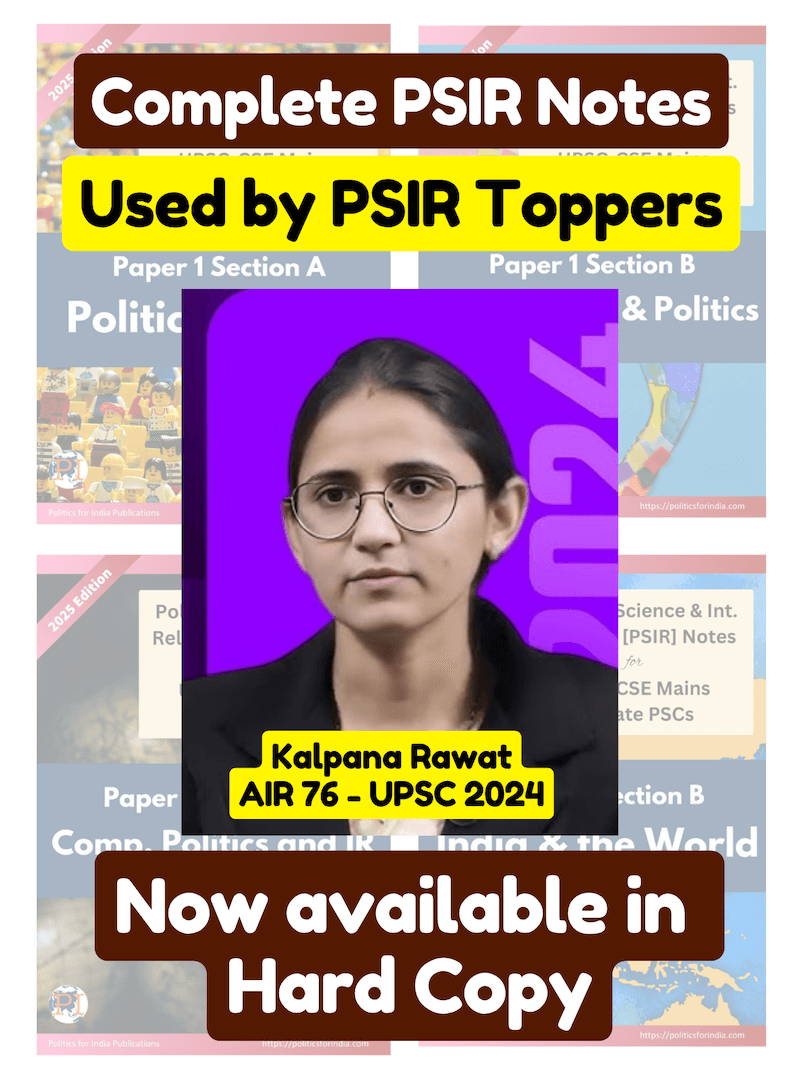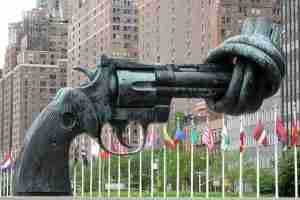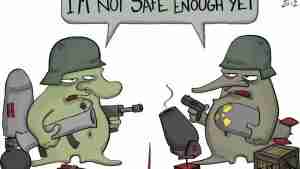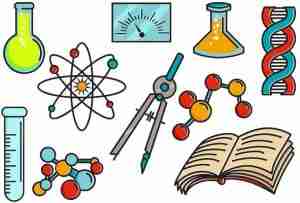1] Party System
Political parties have become a universal feature of political systems worldwide, functioning in both democratic and non-democratic contexts. They perform the essential input function of ‘interest aggregation,’ channelling diverse societal interests into coherent policy agendas. The academic study of political parties, known as stasiology, has evolved into a specialized field with various theoretical perspectives.
Theoretical Perspectives on Political Parties
A] Normative Approach
Edmund Burke offered a normative definition of political parties. He viewed a political party as “a body of men united for promoting by their joint endeavours the national interest, upon some particular principle in which they are all agreed.”
This perspective emphasizes 1) shared ideology and 2) collective action, 3) aimed at serving the national interest.
B] Catch All Parties
Otto Kirchheimer introduced the concept of the ‘catch-all party,’ describing parties that de-emphasize strict ideological commitments to attract a broader electorate. These parties prioritize electoral success over ideological purity, reflecting a shift towards more inclusive and pragmatic political strategies.
C] Lenin’s Theory of the Communist Party
Lenin has given the theory of communist party in his pamphlet WHAT IS TO BE DONE?. On contrary, Marx never accepted the idea of party because party creates hierarchy, goes against the idea of equality.
Lenin believed that workers are not capable of developing the revolutionary consciousness on their own, hence communist party will act as ‘vanguard’ of revolution.
He makes distinction between communist party and trade unions. Trade unions are the parts of bourgeoise systems. Trade unions can get only some concession for workers, whereas communist party can bring workers to power.
Communist party is a secret society as the aim of communist party is to overthrow the state. It is pyramidical in structure. It will be having its cells at the local levels. Top leadership will do what is determined by the base. Bottom up approach.
Communist party works on the principle of democratic centralism. People will communicate to the top leadership, what they want. Top leadership will convert people’s demands into a workable program of action. Once decision is taken by the top leadership, it will be implemented at all the levels and hence it will be centralised.
D] Behavioural Theories of Political Parties
Behavioural scholars focus on the pragmatic aspects of political parties, viewing them as instruments for gaining and exercising power.
Robert Michels and the ‘Iron Law of Oligarchy’
Robert Michels, in his seminal work “Political Parties” (1911), proposed the ‘iron law of oligarchy,’.
He has analysed the internal functioning of socialist parties in Germany to examine the claim of Marxists that socialist parties operate on different principles. He came to the conclusion that there is no difference in the internal functioning. All powers are in the hands of top leadership. Hence he suggested that oligarchy is the iron law, power will always be in the hands of elites. Masses never shape decisions. Thus irrespective of the ideology, all parties operate in a similar fashion.
Maurice Duverger’s Contributions
He has given Duverger law. This law tells the relationship between the electoral system and the party system. If country has simple majoritarian type electoral system, it will have two party system. If country has proportional representation, it will have multi-party system. But India is an exception to the Duverger law, where multi-party system exists with simple majoritarian type.
Duverger has also given the structural analysis of political parties. On the basis of ideology, there are two types of parties.
- Mass parties – Liberal and communists.
- Cadre based parties – Rightist parties.
Furthermore, he identified four types of internal party structures:
- Branch Structure: Common in liberal parties, featuring a network of local branches.
- Cell Structure: Typical of communist parties, organized into small, tightly-knit units.
- Caucus: A small group of influential leaders or elites, often found in rightist parties.
- Militia: Parties with armed wings or paramilitary organizations, such as the fascist parties in Europe.
E] Giovanni Sartori’s Analysis
Giovanni Sartori emphasized that the nature of a party system is determined not merely by the number of parties but by the number of parties with systemic relevance—those capable of influencing government formation and policy.
F] Western vs. Non-Western Party Systems
1] Western Democracies
In established Western democracies, political parties are typically institutionalized and operate within a framework of internal democracy, transparency, and financial accountability. These parties often have clear ideological foundations and are less dependent on individual leaders. This ensures continuity beyond personal leadership changes.
2] Non-Western and Developing Countries
In many developing or non-Western countries, political parties often exhibit a blend of modern organizational structures and traditional practices. Features include:
- Personalistic Leadership: Parties cantered around charismatic leaders rather than institutional frameworks.
- Dynastic Control: Political power often concentrated within specific families or clans.
- Lack of Internal Democracy: Decision-making processes are centralized, with limited input from the broader membership.
- Identity-Based Politics: Mobilization along lines of caste, religion, ethnicity, or region.
- Limited Financial Transparency: Opaque funding sources and expenditures.
2] Pressure Group / Interest Group
Pressure groups are called as invisible empires (Samuel Finer). This shows that the basic difference between political parties and pressure groups is that political parties contest for acquiring formal posts in governmental institutions. Pressure groups do not compete for the formal posts yet they influence the government’s decision making to a significant extent.
It can be said that pressure groups play the game of ‘hide and seek’ in the political system. If political parties perform the role of interest aggregation, pressure groups do interest articulation.
The study of pressure groups has been one of the major concern of political sociologists as they operate at the interface of politics and society. The study of pressure groups is known as pluralism. Pluralistic theory of democracy put importance on the study of pressure groups. e.g. Robert Dahl on the basis of the role of pressure groups in liberal democracies preferred to call these democracies as ‘polyarchies’.
A] Difference in Pressure Groups and Interest Groups
There is no difference in pressure groups and interest groups. Only terminological difference. In traditional approach the term pressure group was preferred whereas in behavioural approach the term interest group is preferred.
Behavioural political scholars wanted to develop standard terminology in political science like it exists in natural sciences. When we use the term pressure groups, we are focusing on the technique employed by these groups i.e. lobbying for promotion of their interests. Whereas when we use the term interest group, we are emphasizing on the purpose i.e. interest articulation. Interest group term is more appropriate because pressure as a technique can be employed by opposition, social movements etc. hence this term may create ambiguity.
B] Types of Interest Groups
1] Gabriel Almond’s Classification
He has classified interest groups into four types.
- Institutional
- Associational
- Non-associational
- Anomic
1) Institutional Interest Groups
These pressure groups are those pressure groups which have are the part of governmental institutions or whose members are part of governmental institutions. Like organisation of civil servants, military personnel, government sector banks etc. They are the most powerful pressure groups because they operate within the system and are in a best possible situation to influence government policies.
Institutional pressure groups are more prominent in developing countries considering the fact that the states in developing countries are ‘overdeveloped states’. In western countries, they may not be as powerful because the western countries normally have minimal state.
However, the difference is only in theory. In reality the situation may vary e.g. Army in Pakistan is the strongest pressure group and that is why army is called as ‘deep state’. Though USA is a democracy, yet USA’s politics gives prominent role to USA’s military and industries. C Wright Mills held that USA is ruled by power elites.
2) Associational Interest Groups
Association denotes the organization which is purely based on the interest. People come together for a particular interest irrespective of caste, colour, nationality, ethnicity or any other ascriptive criteria. e.g. Amnesty international, Green Peace, FICCI, BKU (Bharatiya Kisan Union), SEWA etc.
Such pressure groups are more prominent in western countries. However, in developing countries also the trend is changing since 1990s because of the beginning of globalization. There is a proliferation of these organizations in terms of number and there is an increase in the scope of their impact.
3) Non-associational Interest Group
These pressure groups are based on identity – caste, community, religion, language, race. e.g. Jat Mahasabha, Kshatriya Mahasabha, Gujjar sabha etc. They are exclusive in nature. Membership is based on ascriptive (based on birth) criteria. Non associational pressure groups play greater role in prismatic societies.
4) Anomic Interest Groups
Anomic means normlessness. Pressure groups is a collective activity. There are some sorts of collective behaviours which cannot be put under either institutional, associational or non-associational. They are categorized as anomic pressure groups. Normally the term is used for crowd behaviour or some short term association. e.g. People protesting against the road accident can be called as anomic pressure groups. They are more visible in developing countries because of the lack of institutionalization of democracy.
2] Jean Blondel’s Classification
Almond’s model is static, it does not tell how pressure group politics evolves over a period of time hence Blondel proposed more dynamic model.
Jean Blondel classifies interest groups based on the factors influencing their formation. He divides them into two primary categories: Community Interest Groups and Associational Groups, each with two subcategories.
1) Community Interest Groups
They typically aim to promote the interests of their community. These may exert pressure on the government for protection or assistance. These groups emerge from shared social relationships and communal life, often forming organically within communities. Community interest groups are generally informal, though some may have formal structures.
a) Customary Groups: Customary groups are rooted in long-standing customs and traditions. Their formation is based on inherited social structures, such as caste or ethnic affiliations. In India, caste and sub-caste groups exemplify customary groups.
b) Institutional Groups: Institutional groups consist of individuals who have lived together for extended periods, developing common social relationships. Examples include welfare associations of serving or retired soldiers, civil servants’ welfare associations, and senior citizens’ welfare bodies.
2) Associational Groups
Associational groups are formed through deliberate association, typically organized around specific interests or objectives. They are usually formally structured and aim to influence public policy or protect the interests of their members.
a) Protective Groups: Protective groups seek to safeguard the interests of their members, often representing a homogeneous clientele. Examples include trade unions, professional associations, and associations of traders. These groups tend to have substantial influence over policy-making processes. As Robert Salisbury observed in the context of British groups, protective groups possess “substantial influence over policy,” whereas promotional groups, even with large followings, often have only a minor impact on public decisions.
b) Promotional Groups: Promotional groups aim to advance broader causes that may benefit large segments of society. Their membership often spans diverse sections of the community. Examples include environmental organizations or groups advocating for disarmament. While these groups may mobilize significant public support, they generally exert less influence on policy-making compared to protective groups. Additionally, promotional groups may face challenges in adapting their goals in response to changing political situations.
3] Social Movements
Social movements are also a type of collective behaviour like political parties and pressure groups. The study of social movements is also the main concern of political sociologists.
At times, pressure groups, political parties and social movements can transform into one another. e.g. Indian National Congress started as social movement, changed into pressure group and then into a political party. AAP started as a social movement and became a political party.
Out of the three, social movements are least institutionalized. Social movements have their ideology, leadership, life cycle. Social movement is primarily a feature of left-politics. Social movements are aligned to the left ideology. In liberal discourse, scholars do not prefer to use the term social movements. They prefer to use the term ‘resource mobilization’.
A] Origin of Modern Social Movements
Modern social movements started in the west as a reaction against the exploitation of the working classes. Workers movements were the earliest social movements/left movements. Now these movements are called as old social movements.
New social movements: New social movements started in west in 1960s. New social movements are concerned with developmental issues, quality of life issues. e.g. Environmental movements, Human rights movements, Civil rights movements, peace movements etc.
B] Differences Between Old and New Social Movements
1] Objectives: Old social movements deal with bread and butter issues whereas new social movements deal with quality of life issues like sustainable development.
2] Composition: Old social movements are the movements of lower classes, workers whereas new social movements are primarily the movements by middle classes.
3] Leadership: Whether old or new, the leadership has primarily come from the advanced sections of middle classes. However it does not mean that lower classes have never provided the leadership. e.g. If Lenin was from middle class, Mao was from the peasantry.
4] Techniques: Old social movements primarily used political techniques. Use of force, protests, demonstrations. They take direct action to gain political and economic powers. New social movements use multiple mediums like art, literature, theatre, street performance, movies etc. Their main focus is not on capturing power, but on raising the consciousness.
5] Ideological Orientations: Old social movements are materialistic, whereas new social movements are post materialistic.
C] Difference in Developed and Developing World
In developing world, considering the prismatic nature of the society old and new social movements are not entirely distinct. They are overlapping. e.g. Indian environmental movement is a mix of old and new. As an old social movement, it deals with the livelihood concerns of the tribal, poor, but as a new social movement, it takes up the issues like protection of environment.
D] Recent Examples of Social Movements
1] Black Lives Matter (BLM)
Sparked by George Floyd’s murder by a Police Officer in May 2020, BLM reignited global protests against systemic racism and police brutality. The demands of BLM movement included defunding police departments, investing in Black communities, and dismantling systemic racism.
BLM operates as a decentralized network, emphasizing grassroots activism. Tactics included mass protests, social media campaigns, and community organizing.
While BLM raised global awareness and led to symbolic changes, such as the removal of Confederate statues, substantial policy reforms have been limited. In the U.S., police budgets have largely remained unchanged or increased. Systemic racism remains entrenched, necessitating continued antiracist solidarity
2] Fridays for Future (FFF)
Initiated by Greta Thunberg’s school strike in 2018, FFF calls for immediate action to combat climate change, adhering to the Paris Agreement targets. Led by youth, FFF organizes global climate strikes and leverages social media for mobilization.
Despite mobilization, tangible policy changes have been limited. Studies highlight FFF’s role in fostering collective identity among youth activists especially through digital platforms.
3] Yellow Vests Movement (France)
Originating in November 2018, the Yellow Vests (Gilets Jaunes) movement began as a protest against fuel tax hikes but quickly expanded to broader issues like economic inequality and perceived governmental neglect.
It was a decentralized, grassroots movement without formal leadership, it utilized mass demonstrations, road blockades, and social media mobilization.
The French government responded by suspending the fuel tax increase and proposing minimum wage hikes. Researchers have noted the movement’s unique blend of populist and anti-austerity sentiments.
4] Hong Kong Protests (2019–2020)
Triggered by a proposed extradition bill, protests evolved into a broader pro-democracy movement demanding electoral reforms and police accountability. It largely leaderless. The movement employed mass rallies, sit-ins, and online coordination.
While the extradition bill was withdrawn, the imposition of the National Security Law in 2020 curtailed many freedoms, leading to arrests and a decline in protests.
5] Indian Farmers’ Protest (2020–2021)
In response to three agricultural laws perceived to favour corporations, farmers demanded their repeal and legal guarantees for minimum support prices. Led by various farmers’ unions, the movement utilized prolonged sit-ins, marches, and nationwide strikes.
After a year of sustained protests, the Indian government repealed the contentious laws in December 2021.
6] Myanmar Protests (2021–Present)
Following a military coup in February 2021, citizens demanded the restoration of democracy and release of detained leaders. Known locally as Spring Revolution, these protests are beingled by the National Unity Government and civil society groups. The methods include mass protests, civil disobedience, and online campaigns.
In response to the growing protests, the military leaders of the coup enacted a number of countermeasures. These included internet and social media blackouts, a media blackout, pursuit of arrests and criminal sentences against protesters
The military’s violent crackdown led to ongoing conflict, with parts of the country experiencing armed resistance. Thus, the movement’s evolved from peaceful protests to armed resistance.
7] Bangladesh: The 2024 Student–People’s Uprising (July Revolution)
The movement was ignited in June 2024 when Bangladesh’s Supreme Court reinstated a controversial quota system, allocating 30% of government jobs to descendants of 1971 Liberation War veterans. This decision reversed a 2018 reform that had abolished such quotas, sparking widespread discontent among students and job seekers who viewed the system as discriminatory and a means of political patronage.
The demands of protestors included 1) Abolition of the reinstated quota system in favour of merit-based recruitment. 2) Resignation of Prime Minister Sheikh Hasina and her cabinet. 3) Implementation of democratic reforms and restoration of civil liberties.
The movement was spearheaded by the Students Against Discrimination (SAD), a coalition of university students from across Bangladesh. The organization utilized social media platforms like Facebook and Telegram to coordinate nationwide protests, human chains, and blockades.
The government’s initial response was marked by severe repression. Deployment of police and paramilitary forces, use of live ammunition, tear gas etc. The violence peaked during the July Massacre, with estimates of over 1,500 deaths and thousands injured.
Facing mounting pressure, Prime Minister Sheikh Hasina resigned on August 5, 2024, and fled to India. An interim government was established, led by Nobel Peace Prize laureate Muhammad Yunus, tasked with restoring democracy and organizing free elections.
Scholars have highlighted the deep-rooted structural issues and the youth’s role in challenging authoritarianism. The movement also underscores the role of social media.
4] Electoral systems
A] Importance
Since representative democracy has become inevitable, electoral systems have become part and parcel of any theory of democracy. Any electoral system has to be free and fair, representative with minimum wastage of votes. It is to be noted that democracy is needed for the protection of minorities. Hence electoral system should be such, which gives enough space for the representation of the views of minorities. Real democracy is not majoritarian, but consociational.
B] Types of Electoral System
1] Majoritarian Representation Types
A majoritarian electoral system is designed to ensure that elected candidates or parties secure a majority of votes, (more than 50%), to win an election. This system emphasizes decisive outcomes. Majoritarian systems simplify governance and decision-making. However, it is also suggested that such system marginalize smaller parties and minority groups.
Types of Majoritarian Representation Systems:
1] Simple Majoritarian Type
It is least representative of all system. Maximum amount of wastage of votes occurs here. Because is based on the idea of winner takes all. Its only merit is its simplicity. It favours the national parties, or parties operating at a bigger level.
Examples include India’s election for Lok Sabha and Legislative Assembly members. Election of house of commons in USA.
2] Second Ballet
In this system, winning candidate needs absolute majority and not just the plurality of votes. It means winning candidate must get 50% +1 of total valid votes.
There is also a possibility of two elections. In the first round, if no candidate gets absolute majority then the second run of election takes place. In the second round, only two top candidates are in the election. When only two candidates participate, one is bound to get 50% + 1 votes.
It is more representative but it has its drawback of unnecessary expenditure and extra burden on electoral machinery, electoral fatigue etc.
For example the presidential election in France, Sri Lanka take place by this method.
3] Alternative Vote System
In this system, winning candidate requires absolute majority, but there is no need to conduct elections for the second time. Therefore it is an improvement over second ballet.
Voters are supposed to write their preferences. In case no candidate gets absolute majority, then the candidate who is least preferred is eliminated. The second preference of the voters will be seen. These are the voters who had given the first preference to the eliminated candidate. Now their votes are transferred to their second preference. This transfer keeps on happening until a particular candidate is able to secure absolute majority.
Example: members of house of representative in Australia.
2] Proportional representation
Even when absolute majority is introduced, large majority remains unrepresented. Hence proportional representation has been introduced. Proportional representation ensures that democracy does not become tyranny of majority. It ensures that the voice of minority gets represented. Proportional representation results into coalition governments.
1] STV (Single Transferrable Vote system)
The Single Transferable Vote (STV) system is a form of proportional representation designed for multi-member constituencies. In this system, voters rank candidates in order of preference.
To be elected, a candidate must achieve a specific quota of votes, calculated based on the total number of valid votes and the number of seats to be filled. If a candidate surpasses this quota, their surplus votes are transferred to other candidates based on voters’ subsequent preferences.
If no one meets the quota, the candidate with the fewest votes is eliminated, and their votes are redistributed. This process continues until all seats are filled, ensuring a more proportional representation of voters’ preferences.
In India, the STV system is employed in the election of the President, as stipulated by Article 55 of the Constitution. Although the President is a single officeholder, making it a single-member constituency, the election uses a variant of STV. Here, the ‘quota’ effectively becomes an absolute majority.
2] List system
This is regarded as the most representative of all. Mostly used in continental Europe. The merits of the system include
- Minimum wastage of votes.
- Elimination of personality factor and importance of the political parties.
- Gives representation to the weaker candidates who may not have chances to win on their own but can be introduced on the party list.
- There is no need to give reservation.
In this system, entire country is converted into single constituency. But it is a multi-member constituency. Each party will get seat in the legislature in proportion of the votes. Party will send the required number of candidates. For example if a party secures 30% of total votes, it will send 30% of total candidates to the assembly.
The elections in Israel are conducted in this manner. There can also be provision of minimum benchmark. e.g. In Israel, party has to get 3.25% of the votes to qualify for the seat in the legislature.
In practice, it is difficult for any party to secure 50% of total votes and hence list system often gives rise to coalition politics.
C] Methods of Minority Representation
- Proportional representation – both STV and List system. It is a joint electorate system.
- Separate electorate – Separate electorate may be threatening to the national unity hence proportional representation is a preferable approach.
- Reservation like that in India.
















What is the different between these notes and the pdf notes [ which costs for 340 rupees]
difference*
There is NO difference as far as CONTENT is concerned. There is some difference of PRESENTATION. In PDF notes (can be purchased here: https://products.politicsforindia.com/), you get images of scholars in between the notes. Those images are not given here.
Hi Admin,
We can add here one recent social movement in Nepal this year 2025, which can showcase a culmination of both old & new method of social movement, where massive & widespread youth demand, led to downfall of feudal government ruled by a family or clans against corruption in govt system followed by social media ban.
Oh yes Akhilesh. You can cite it like this. In fact, while the objectives can evolve, the old methods won’t be altogether be discarded in favour of new methods of social movements. So this should be natural as such.. and can be written like that.